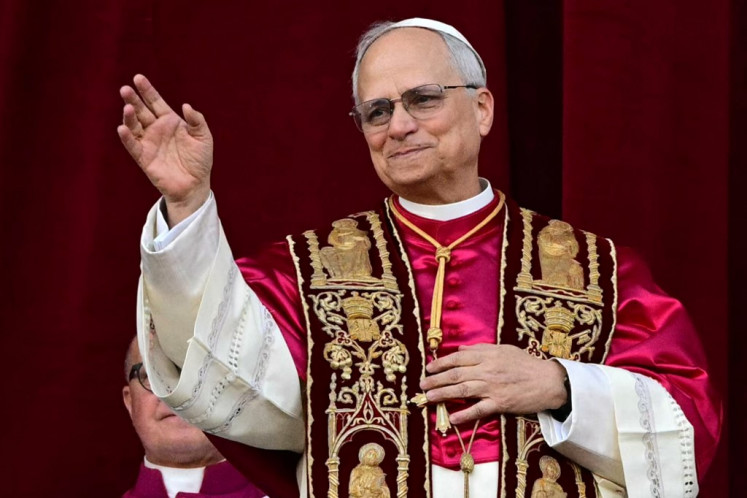In Malang, Hindus keep the 'ogoh-ogoh' alive
The demon awakes: A nearly finished ogoh-ogoh awaits the Day of Silence
Change text size
Gift Premium Articles
to Anyone

The demon awakes: A nearly finished ogoh-ogoh awaits the Day of Silence.
There's a small community of Hindus in Glanggang in Malang, East Java, getting ready to observe Nyepi, or the Hindu Day of Silence, on Saturday by making giant ogoh-ogoh effigies. Even their mostly Muslim neighbors are getting in on the act.
Sungkono, 52, is a Hindu striving to maintain his ancestral customs. 'As religious followers, we certainly always strive to perform what we've been taught.'
The 52-year-old ' a tempeh maker who lives in the hamlet of Karang Tengah ' said the tradition dated to 1966, when ogoh-ogoh were as small as 50 centimeters.
After the government declared Nyepi a national holiday in 1983, larger versions began to surface. 'We started crafting bigger ogoh-ogoh in the early 1990s,' he said.
Nyepi is typically preceded by a series of religious and cultural ceremonies that climax during the Tawur Agung Kesanga ceremony, when effigies and offerings are presented during a procession held the day before the holiday.
Ten families in the village have been busy making ogoh-ogoh, he said. Work typically starts a month before the big day. 'It's not difficult to build ogoh-ogoh, but as we do so during our spare time after work, we have to start early.'
The bamboo frame, one of his effigies under construction, could be seen on Sungkono's terrace. Materials used to make the giant puppets include wood, bamboo, used newspaper and cement sacks, paint, glue and wire or plastic strings to fasten bamboo frames.

For a 2-meter ogoh-ogoh, Sungkono says he uses at least 10 bamboo stems and 2 kilograms of paint.
The style for effigies could be updated from year to year, he adds. 'In this Internet age, we just need to find and choose the models posted online to find modifications.'
'An ogoh-ogoh represents Bhuta Kala, an ogre, which in Dharma Hindu teachings bears the evil traits of man,' Sungkono said.
Accordingly, only the most frightening figures are crafted. After a paraded, the effigies are burned to rid the world of evil spirits.
Sometimes the effigies take the form of animals, although Sungkono says models of animals useful to humans, such as horses or cows, are not allowed. 'Even snakes are not used, because they eat rats in paddy fields,' he added.
Rats, flies or mosquitoes are the most popular options.
The minimum cost of an effigy is Rp 400,000, which goes to the team making it after the festivities.
'Normally there are five to eight people working together without earning money, but with meals and drink provided,' he said.
Sometimes even non-Hindus pitch in. 'The essence of ogoh-ogoh is providing mutual assistance.'
While the Tawur Agung parade in the village always takes place at 8 p.m., roads are packed with eager residents and visitors starting in the afternoon.
'Non-Hindu residents are not bothered,' Sungkono said, 'There's positive synergy, because while watching our tradition, they can earn extra income from parking fees, the sale of food and beverages or children's toys.'
Meanwhile, Sai, 40, a Hindu from nearby Karang Pandan village, also builds ogoh-ogoh.
Although people in Karang Tengah prepare effigies for their own use, Sai, a gas station worker, builds them to order.
'Usually I receive up to five ogoh-ogoh orders every year,' he said. According to Sai, effigies are priced according to size. A 2 m puppet carried by 4 to 6 people costs Rp 900,000 to Rp 1 million, while a 4 m puppet carried by 10 people can fetch up to 1.5 million.
A big effigy takes one to two weeks to get ready. As a rule, Sai takes orders starting two months ahead of Nyepi.
Two of his effigies can be seen during a visit, one of which takes the form of a giant with long hair tied. 'This 2.5 m giant symbolizes the cunning character of Sengkuni,' he said, referring to the famous shadow-puppet character.
Like his neighbors, Sai builds these effigies on a mutual assistance basis. 'We continue to maintain harmonious ties with other believers. We haven't experienced any problems thus far, so thankfully Nyepi ceremonies have always run safely and smoothly.'
' Photos By Nedi Putra AW









